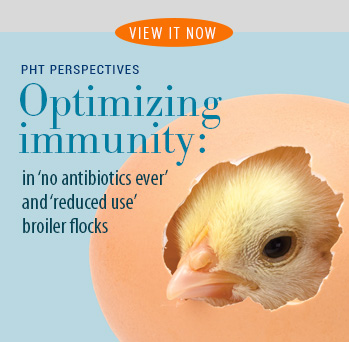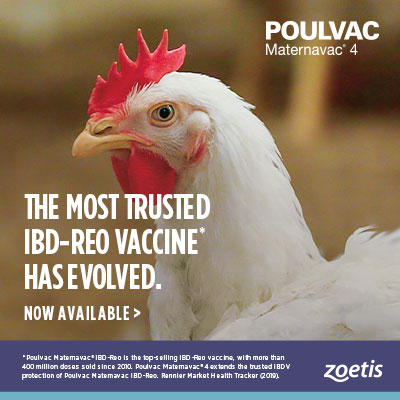QX, 793b found to be most prevalent IBV field strains in Europe
Two recent studies assessed the prevalence of various infectious bronchitis virus (IBV) strains in Europe in recent years, with QX and 793b proving the most common causes of virulent disease in chickens.
The findings are based on molecular analyses of field isolates obtained from mostly broiler as well as some layer and breeder chickens throughout Europe. One study (Study 1) looked at samples from throughout the EU in 2018,1 while the other (Study 2) assessed IBV variant prevalence in the Iberian Peninsula between 2014 through 2017.
In both studies, scientists from Zoetis took samples primarily with tracheal or cloacal swabs; most flocks were sampled because of suspected outbreaks of IBV, but in some cases the testing was routine. A total of 1,942 sites were sampled in Study 1 in 14 countries (Figure 1), though only Belgium, France, Germany, the Netherlands and Poland provided samples in significant numbers. In Study 2, the samples were taken from a total of 548 sites in Spain and Portugal.2
Multiplex qPCR testing
Following sampling, the scientists extracted viral RNA and reverse transcribed it into DNA for analysis with a commercially available quantitative polymerase chain reaction (qPCR) test kit. A first test was used to detect the presence of IBV; positive samples were then tested a second time with selected sets of strain-specific primers and probes for the major variants present in each region studied. These included 793b, Massachusetts, D274, Italy-02, Arkansas, D1466, QX and Variant 2 in both studies. Study 2 additionally tested for Q1. Samples found to be positive for IBV but negative for the tested strains were sequenced at an external laboratory for further identification.
“The main advantage of this multiplex qPCR technique is that we can detect more than one serotype from a pool of samples,” explained Alberto Giner, DVM, poultry technical manager at Zoetis and one of the study investigators. “The normal type of sequencing can only detect one, so with this test we can get a better picture of what’s going on in the field.”
To differentiate field strains from vaccine strains, the scientists leading Study 1 grouped the qPCR results by cycling threshold (Ct) value: “low” (less than 25), “medium” (between 25 and 30) and “high” (greater than 30).
The Ct value indicates the number of testing cycles needed to demonstrate the presence of a given virus strain, Giner explained. The lower the Ct value, the higher the amount of viral material in the sample, which corresponds to a greater probability that a strain not present in the vaccination scheme is a field virus, he added. Meanwhile, a high Ct value for a strain that was part of the vaccination program could indicate a vaccine strain.
In Study 2, results were filtered to exclude samples from flocks that received vaccines homologous to the tested strains or for which no vaccination information was available. By doing so, positive samples could be considered as field virus rather than virus of vaccine origin, Giner explained.
Results
Results from both studies demonstrated that QX and 793b were the most prevalent likely field strains in the European regions and time periods studied.
In Study 1, the top three serotypes recovered overall were 793b (57%), Massachusetts (39.1%) and QX (28.3%), though analysis based on vaccination history and Ct values indicated that Massachusetts recoveries were mostly of vaccine origin (Figure 2). The relative prevalence of likely field strains varied by country, however (Figure 3).

* Note: Since the test can detect more than one serotype in any given sample, the sum of the percentages in the table above is >100%.
“Though QX and 793b were found to be the most prevalent overall in this study, Variant 2 was predominant in Poland, with QX being second,” Giner said.
“In France, detection of 793b was much higher than that of QX, though the 793b strain recovered was found to have a high degree of homology with vaccinal strains. This suggests possible spread of the vaccine strain beyond farms that administered it,” he added, noting that 793b vaccine spreading was also recently observed in studies in Greece and Poland.3,4
In Spain and Portugal, QX and 793b were also found to be the most predominant variants in all years studied (Figure 4). When the QX and 793b results were filtered to exclude all samples coming from flocks vaccinated with vaccines that were homologous to the tested strains, or when no information about used vaccines was provided, QX was found to be the most prevalent genotype in the Iberian Peninsula, accounting for between 56.3% and 94.7% of probable field strains (Figure 5).
“The high prevalence of QX among probable field strains detected in both of these European studies reinforces the importance of including a homologous QX vaccine in IBV control programs,” Giner said. “Furthermore, laboratory experiments demonstrate that vaccinating against QX and Massachusetts provides robust cross-protection against 793b, helping to keep flocks protected against the most virulent strains of this economically important pathogen in Europe.”
1 Blond et al. Presence of Infectious Bronchitis Virus Variant Strains in Europe and the Mediterranean Basin in 2018. Poster, WVPA 2019.
2 Giner et al. Infectious Bronchitis Virus Genotypes in the Iberian Peninsula (Spain And Portugal) from 2014 to 2017. Poster, WVPA 2019.
3 Legnardi et al. Vaccine or field strains: the jigsaw pattern of infectious bronchities virus molecular epidemiology in Poland. Poult Sci. 2019 Dec 1;98(12):6388-6392.
4 Andreopoulou et al. Molecular epidemiology of infectious bronchitis virus and avian metapneumovirus in Greece. Poult Sci. 2019 Nov 1;98(11):5374-5384.
DISCOVERIES, Issue 11
Discoveries is a series of research news reports written by the editors of Poultry Health Today® on behalf of the Global Poultry Business of Zoetis.
MM-11784
December 2020
Posted on December 22, 2020





















